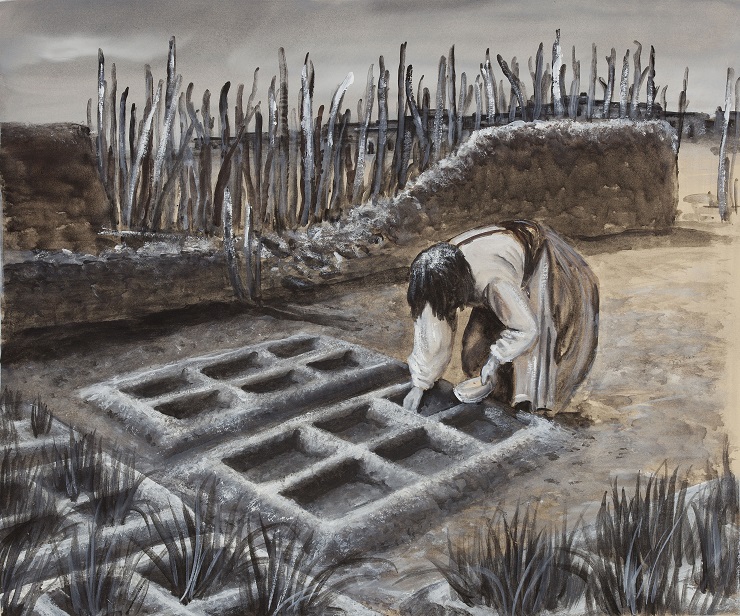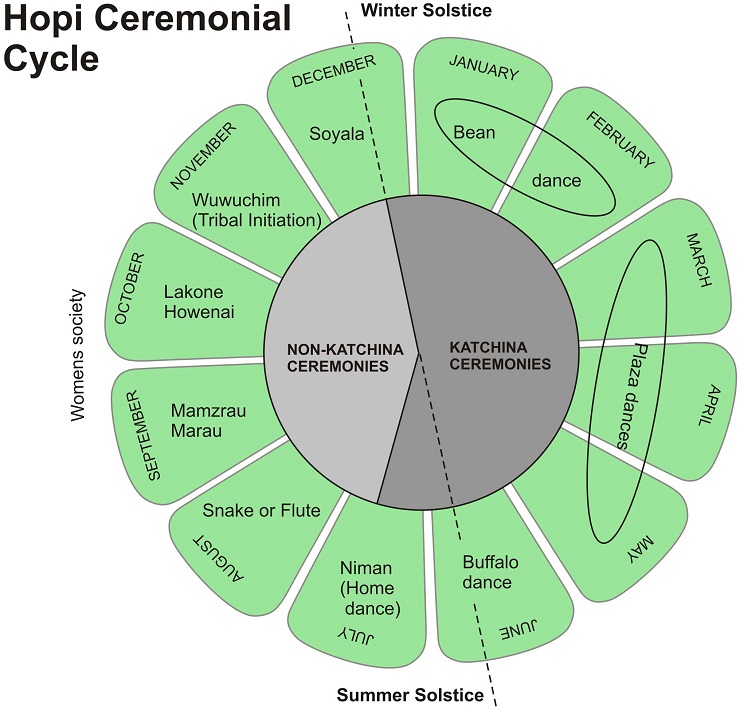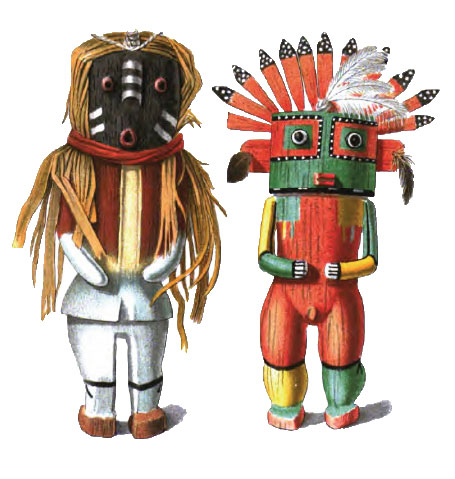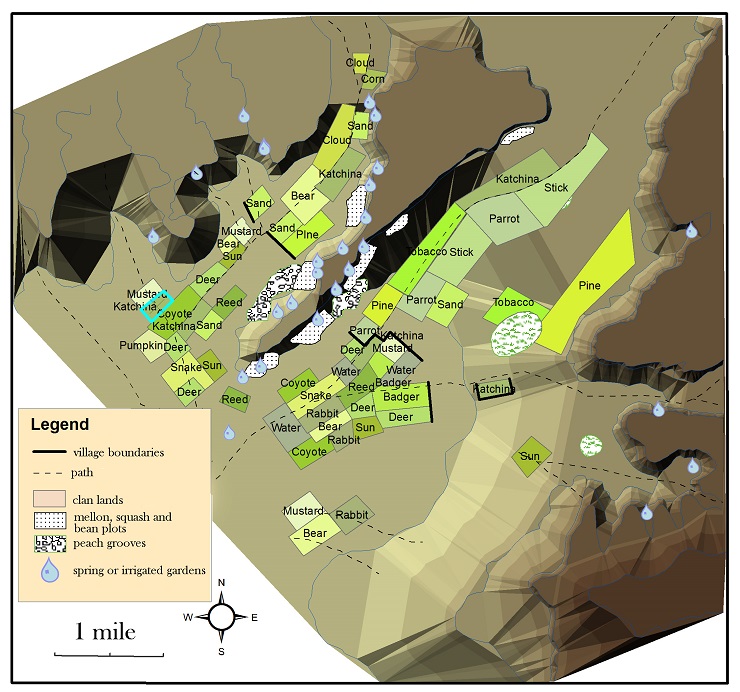 |
| The specific method of adjusting Hopi fields into the form of small square clay pens for each plant was based on the necessity to keep the seedlings moist and to protect them from any sudden shower of rain. Illustration by Petr Modlitba. |
The Hopi represent an example of an archaic society of the pre-state type, whose economy has been based on intensive agricultural cultivation. The word “Hopi” means either “good in every sense” or “peaceful people”. The Hopi settled in the southwest of USA in what is now the state of Arizona, using locations on the mesas that are formed of sandstone. Even today there are 12 separate settlements for this population - in 1990 the number of inhabitants amounted to slightly fewer than 10,000 people.
 |
| Ceremonial cycle was the pivot of both spiritual and everyday life of the Hopi. |
During the prehistoric period (i.e. before the middle of the 16th Century) the Hopi economy was based on growing crops, which was also supplemented by hunting and gathering. From the Spanish colonists they later adopted the breeding of domestic animals - horses, donkeys, mules, sheep and cattle. In terms of agriculture they were obliged to cope with a significant lack of moisture. Apparently the Hopi lived either in small rural settlements or in towns of the pueblo type. There were several of these larger settlements prior to the massive Hispanic colonisation and each of them was inhabited by cca. 500 people on average. The largest pueblo, Oraibi, however, in the 16th Century held perhaps 1500-3000 inhabitants. Despite the significantly adverse natural environment the Hopi did not migrate and they inhabited their settlements over the long term. In addition to town apartments people also built other abodes in different locations - during periods of intensive agricultural work they may have moved for some time to houses located closer to the farmland area.
Historically, for the Indians of the pueblos, the most important crop was corn and then additionally there were also beans, gourds and cotton. Later they adopted the cultivation of apricots, peaches, chili peppers and other crops. The lack of moisture problem was solved by building efficient irrigation systems – using canals and drains – through which water was supplied from artificial reservoirs that were located close to the springs. Fields were created wherever suitable soil was available, up to a distance of 10 km from the individual settlements. The pueblos were built in accordance with a unified layout diagram. The structures, built of adobe clay bricks on stone foundations, were adjacent to each other, thereby forming street rows. These structures could have up to three floors, with several rooms on each of them.
A typical feature of the material culture of the Hopi was and remains its pottery. In the 1960’s – 1970’s research was conducted – i.e. a probe into the pottery domain of the pueblo’s inhabitants – using both ethnological and archaeological methods. In actual fact, all of the producers of local pottery were female, though no rule excluded men from this activity. The production included seven or eight technological forms of pottery of different styles and functions. The designs satisfied the tastes of the buyers, but of greater importance was their technological quality. The pottery and the other production activities took place directly in the pueblos, or in their immediate vicinity.
 |
| The Hopi perceived Katchina idols as being messengers from the spirit world. According to Fewkes, 1894, Board 11. |
Each household was formed as a relationally linked group. In the Hopi settlements groups of this kind were headed by women. Individual families were linked together in relationally and genealogically defined clans, thereby forming a community structure in individual settlements. The matrilineal clans of the Hopi did not have completely equality, but nevertheless they formed semi-hierarchical relationships based on the principle of their length of residency, meaning that the clan that had lived in the pueblo for the longest time was the most highly esteemed. Although the social status of individuals was relatively egalitarian, the ambitions in regard to individual social growth were determined in accordance with the clan affiliation. The pueblo chieftain, for whom the term kasik, imported from the Caribbean, is often used, was selected from amongst the male members of the most senior clan.
The individual settlements, however, were not all socially equal. The pueblo theoretically constituted an endogamous separate unit with its own economic potential and political establishment. In actual fact, however, hardly any of the settlements were completely and totally independent. Here we are not referring to subsistence independence but to spiritual independence. Based on the social dynamics within clans there were regular splits in the residential community, in the course of which the outgoing inhabitants decided to construct their own pueblo. Their affiliation to the maternal colony was preserved, however, especially with regard to the domain of everyday ritual. Subsidiary settlements had neither the “right” nor the requisite “know-how” to carry out the complete ceremonial cycle throughout the year, and therefore on these other occasions its inhabitants had to return to the mother pueblo. Over time, the new pueblos inhabitants would be able to acquire the necessary knowledge of secret societies and to carry out all of the ceremonies independently. This, however, usually only occurred when their subsidiary settlement itself became another maternal colony for a different splinter group.
|
|
| Clan ownership of the agricultural land located close to the pueblo on First Mesa. Adapted from Forde 1931, 361-362. |
Want to learn more?
- Beaglehole, E. 1937. Notes on Hopi economic life. Yale University Publications in Anthropology Number 15. New Haven: Yale University Press.
- Graves, M. W. 1998. The History of Method and Theory in the Study of Prehistoric Puebloan Pottery Style in the American Southwest. Journal of Archaeological Method and Theory 5 (4):309-343.
- Kennard, E. A. 1979. Hopi Economy and Subsistence. In Handbook of North American Indians, vol 9., ed. A. Ortiz, 554-563. Washington: Southwest Smithsonian Institution.
- Stanislawski, M. B. 1973. Ethnoarchaeology and Settlement Archaeology. Etnohistory 20 4:375-392.
- Stanislawski, M. B. 1977. Ethnoarchaeology of Hopi and Hopi -Tewa Pottery Making: Styles of Learning. In Experimental Archaeology, eds. D. Ingersoll, J. E. Yellen, and W. Macdonald, 378-408. New York: Columbia University Press.
 Archeologické 3D virtuální muzeum
Archeologické 3D virtuální muzeum

.jpg)
